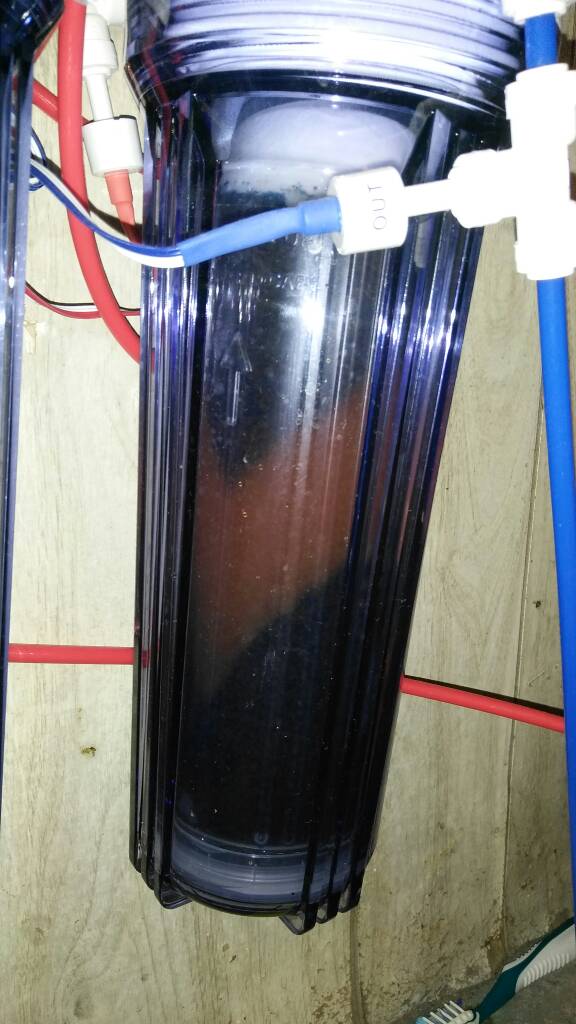I'm new to this. So bare with me friends. This is going to be long LOL.
I purchased and installed the 4 stage BRS value plus RODI system 7 mos ago. About a month ago (maybe two) my TDS started to creep up from 0 and I'm now up to 6. At the same time the TDS started creeping, I had to relocate the tank and started battling diatoms or dinos (not sure which). So I need to know if it's related to one of these filters or the move or both. If it's related to filters I'd like to know which particular filter it could be related to. I'm fully aware that the general consensus is to change the sediment filter and the DI resin at 6 months and the carbon blocke at 1 year. However I am also fully aware that it can be more economical for me to know exactly when and why to change each filter.
So let's start with the sediment filter. I've read that it should be changed at 6 months or when clogged which can be indicated by low pressure or color change to brown. Well yes it has been 6 months but it has not changed color at all it is pure white and my pressure has always been between 70 and 80 psi and remains there. So should I change it just because it's been 6 months and I have TDS? And could this filter have anything to do with any of the two algae I mentioned above?
Now let's talk about the carbon block. From my understanding the carbon block needs changed every year or when the chloramines start to creep up. Well we're not quite at a year yet and my incoming chloramines from my tap water only measure at 0.5. I checked the chloramines on the product water and the Wastewater and got 0 at both. Just want to verify that I'm correct that this has nothing to do with my TDS and I'm not having to replace this but could this filter be the cause of one of my algae above?
As far as the DI resin goes, I know they recommend changing it at 6 mos. So it's due but it has not completely changed colors. Only a small portion has changed. I'll include a pic, but can this be the source of TDS and/or algae?
Then there is the membrane. I know they say 2-3 yrs. So I doubt at 7 mos it's an issue, but I have no idea how to indicate when it's truly bad. Can you tell me?
My last question is in what sequence of filters does the water flow through these filters?
I apologize for such a long thread with many questions just trying to learn as much as I can and cover my questions.
I purchased and installed the 4 stage BRS value plus RODI system 7 mos ago. About a month ago (maybe two) my TDS started to creep up from 0 and I'm now up to 6. At the same time the TDS started creeping, I had to relocate the tank and started battling diatoms or dinos (not sure which). So I need to know if it's related to one of these filters or the move or both. If it's related to filters I'd like to know which particular filter it could be related to. I'm fully aware that the general consensus is to change the sediment filter and the DI resin at 6 months and the carbon blocke at 1 year. However I am also fully aware that it can be more economical for me to know exactly when and why to change each filter.
So let's start with the sediment filter. I've read that it should be changed at 6 months or when clogged which can be indicated by low pressure or color change to brown. Well yes it has been 6 months but it has not changed color at all it is pure white and my pressure has always been between 70 and 80 psi and remains there. So should I change it just because it's been 6 months and I have TDS? And could this filter have anything to do with any of the two algae I mentioned above?
Now let's talk about the carbon block. From my understanding the carbon block needs changed every year or when the chloramines start to creep up. Well we're not quite at a year yet and my incoming chloramines from my tap water only measure at 0.5. I checked the chloramines on the product water and the Wastewater and got 0 at both. Just want to verify that I'm correct that this has nothing to do with my TDS and I'm not having to replace this but could this filter be the cause of one of my algae above?
As far as the DI resin goes, I know they recommend changing it at 6 mos. So it's due but it has not completely changed colors. Only a small portion has changed. I'll include a pic, but can this be the source of TDS and/or algae?
Then there is the membrane. I know they say 2-3 yrs. So I doubt at 7 mos it's an issue, but I have no idea how to indicate when it's truly bad. Can you tell me?
My last question is in what sequence of filters does the water flow through these filters?
I apologize for such a long thread with many questions just trying to learn as much as I can and cover my questions.










